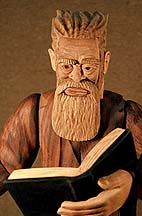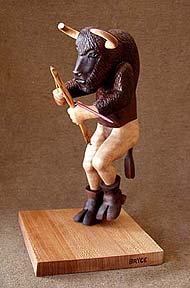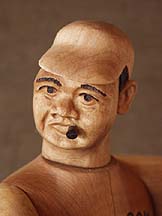American Icons
(and Tricksters)

Glooscap ("The Liar")
|
This series began with a commissioned portrait of Margaret Mead back in the 80s. That piece was my first portrait likeness, but it was more than that. Margaret was a personage, and iconic –– a force of nature when she blew through our lives, and an emblem of the American Experience. She also lived on the boundary –– between cultures, between academe and the pop culture, between new ideas and old contentions –– so she was a Trickster, too.
|
|
When I did a mechanical caricature of Ben Franklin, a few years later, the notion of a series of American Archetypes began to stir. I considered charting an "American Solar System." Ben could be Mercury, bringing down the lightening from heaven. A man who preached conservative verities, and plotted a revolution –– another Trickster. As always happens, you start off chasing one hare, and pretty soon you're lost in the woods. Each image I imagined showed me a new path. I wanted to capture some iconic figures and tell The American Tale through larger-than-life personalities, but a few planets quickly became a whole universe. Emblematic figures from our past don't just tell us about the history of events. They represent the evolution of culture and ideas –– and they symbolize the transformations of American Consiousness. Did I want to tell the outer story of American History through a collection of iconic personalities, or illuminate an inner tale about the archetypal forces converging in the American Soul? Or both? |
|
Art talk is wonderful. It's so full of portentious self-inflation. Here I am setting out to tell The Whole American Story (and analyze our collective psyche) in a series of toy portraits? Lucky for me The Trickster is always ready to prick my balloon. The next icon I conjured up was Elvis. The King –– or is he Pluto? Elvis straddles the divide between Black and White music, where gospel and the driving beat met good old boy Pop Country –– and spawned Rock and Roll. His charismatic charge has only grown stronger since his death. Maybe Elvis is our Pluto. Certainly he's the American Adonis. And the King who must die. |
| If you have a Pop King, you need a Queen –– or a Goddess. Marilyn was the American Venus before we had a sexual revolution. Dumb Blond or savvy actress? She stands at the crossroads where feminine sexuality meets "masculine" will and intelligence. She tried to marry both, and became a tragic victim of the collision. You don't have to die tragically to become a folk hero, but it helps. |
| "American Icons" began to look like a collection of transitional figures, caricatures representing the convergence of different streams in the American River. Maybe it was time to go back and deal with first contacts. Who better to symbolize the European "discovery" of Native America than Capt. John Smith and Pocahontas? Smith was certainly a liminal figure –– one who disrupted the boundaries. But, like so many "disoverers," he was swallowed by the gap between the Old World and the New. As was Pocohantas. |
| Then along came September 11. If America is the great Mecca of human aspirations, do we have the fundamentalist terrorist among our pilgrims? Sure we do. John Brown was an ideological zealot who imagined a universal slave revolt to overthrow that great evil, the peculiar institution. His capture of the arsenal at Harper's Ferry was the Civil War's 9-11. Brown is the American Zealot who marked a pivotal moment –– when Emancipation left the debating society, and became a matter of Sharps carbines. Just a dangerous radical when they hung him, by the end of the era they were singing, ".. his truth goes marching on." A cautionary figure –– American Trickster as Terrorist. |
| If you want to illustrate all the forces colliding in the American Experience, maybe it isn't enough to just tell the human story. What about Flora, and Fauna, and Mother Earth herself? When we were on our American Sabbatical, I was searching for emblematic images in the landscape. One night I saw collosal cthonic figures punching up mountains, huge beings looming in the terraine. Geologic forces were the primal American Culture Heroes, and Orogeny was my first essay in imagining them. |
| Back in the 20th Century, that stupendous cultural collision we call Jazz came in off the streets of New Orleans to play at Carnegie Hall. In The Big Easy the Melting Pot is always at a boil, and it was a street orphan with a battered cornet who taught us all to cook. Louis Armstrong is the American Trickster with a Horn. |
| Then it was Spring again, and I thought about vernal personalities in the American grain –– those who planted in the wild. Johnny Appleseed certainly lived on the boundary –– between the wilderness and the sown, Indian and settler, secular and devout, sober and ecstatic. He sowed Swedenborgianism along with his scions, and left a lot of hard cider in his wake. Like other Culture Heros, Chapman turned one kind of refuse (seeds from the cider mills) into a lasting treasure. Johnny may have envisioned a wilderness blooming with cider apples, but he's responsible for all the moder varieties of apple –– sweet and sour alike. A hard core Trickster. |
| And what about the Native American thread in our cultural tapestry? Glooscap is the Abnaki Culture Hero –– our local Trickster. His stone canoe travels at his will, and the smoke from his pipe makes our Maine fog. At that place between the Maine landscape and the human condition Glooscap sits smoking, and telling lies. |
| My categories are dissolving. This Buffalo Dancer is clearly a Perennial Dancer in form, yet he isn't part of the local tribe. An icon of the American Warrior. Certainly out of the native mythos. |
| Then there's that perennial trick on the Red Sox, the Curse of the Babe. The sports hero as Trickster. The immortal innocent as superhero. The man who won't eat asparagus. |
| Every time I concoct one of these American Icons, I see a dozen more. Sacajawea and the Whale. George Washington, Frederick Douglass, Eliza Pinkney and Glaciation. Leif Erickson and the Corn Diety out of Oaxaca. Mammouth hunters in Beringia and Lincoln riding circuit. Bristol fishermen off Damariscove and Mike Fink (half horse, half alligator). I'd be delighted to have your input. |











